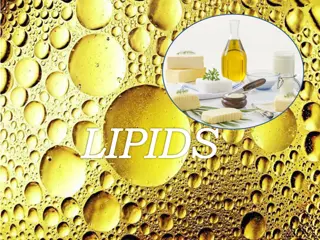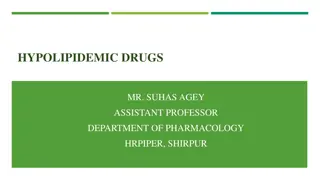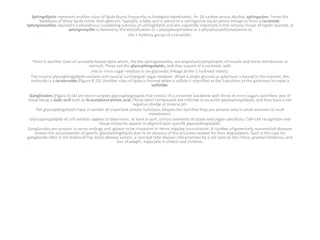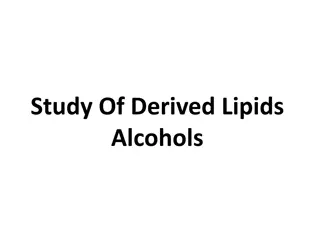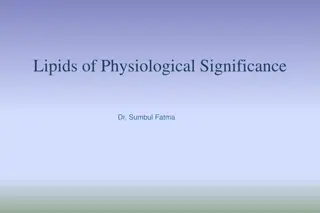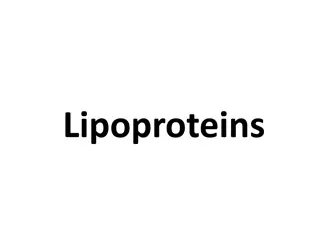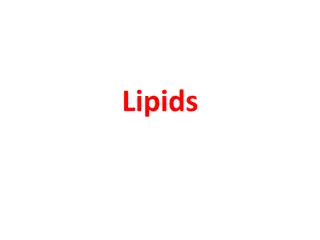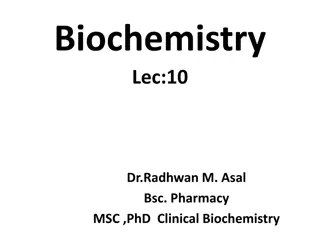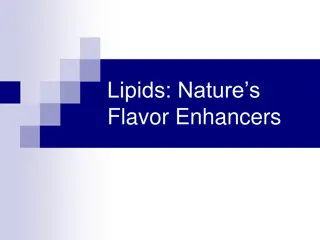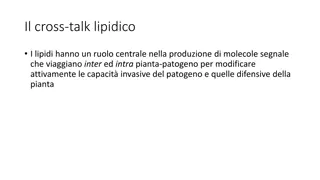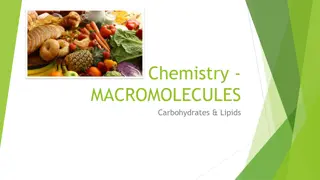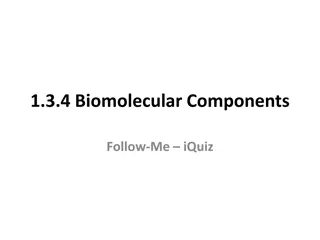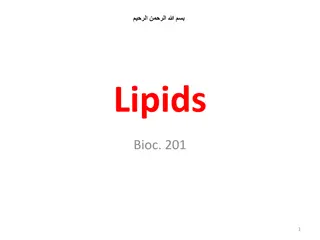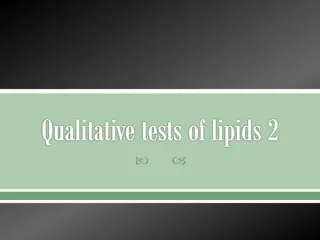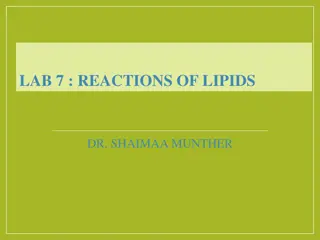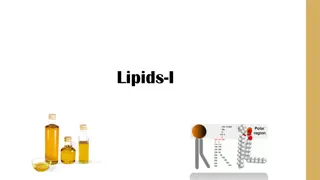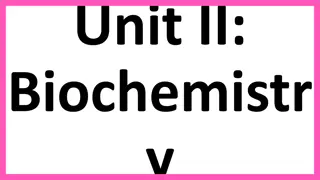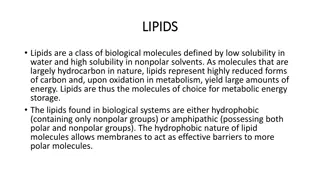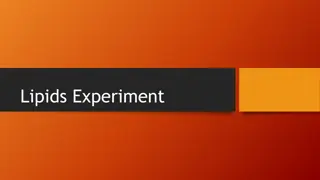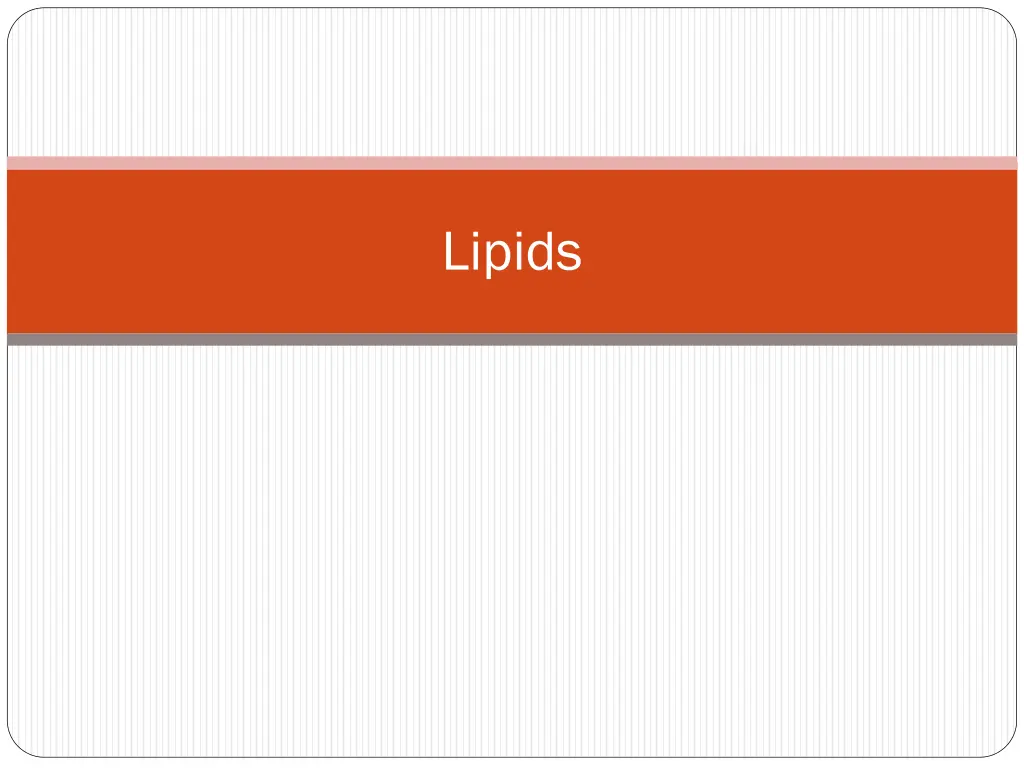
Understanding Lipids: Types, Roles, and Qualitative Tests
Discover the world of lipids - nonpolar organic compounds essential for all living organisms. Explore their classification, biological roles, and qualitative tests to better understand these vital molecules in biochemistry.
Uploaded on | 1 Views
Download Presentation

Please find below an Image/Link to download the presentation.
The content on the website is provided AS IS for your information and personal use only. It may not be sold, licensed, or shared on other websites without obtaining consent from the author. If you encounter any issues during the download, it is possible that the publisher has removed the file from their server.
You are allowed to download the files provided on this website for personal or commercial use, subject to the condition that they are used lawfully. All files are the property of their respective owners.
The content on the website is provided AS IS for your information and personal use only. It may not be sold, licensed, or shared on other websites without obtaining consent from the author.
E N D
Presentation Transcript
Lipids are. It can be defined as nonpolar organic compound insoluble in polar solvent , but soluble in organic solvents such as benzene ,ether, chloroform. Biological role of lipids: Lipids are found naturally in all living organisms. 1)It presents in cell membranes, 2) An essential source of energy in the body. It give more energy than carbohydrate and proteins.
Classification of Lipids lipids can be divided according to their chemical composition to: I) Simple lipids. II) Compound (conjugated) lipids. III) Derived lipids .
I) Simple lipids I) Simple lipids These compounds are: esters of fatty acids with alchol. a)Neutral lipids Esters of fatty acids with alcohol(glycerol) e.g. :Triacylglyceride. : b) Waxes Esters of fatty acids with mono hydroxyle alcohol and higher than glycerol (high molecular weight) e.g.: Beeswax
II) Compound (conjugated) lipids. II) Compound (conjugated) lipids. Lipids are linking with other compounds such as , , Proteolipids Phospholipids, Glycolipids .
III) III) Derived lipids . Derived lipids . They are substances that are soluble in lipid or derived from the lipids by hydrolysis; for examples, cholesterol and fat soluble vitamins.
Qualitative tests of lipids: Qualitative tests of lipids:
Experiment 1:Solubility test Solubility test Fats are not dissolved in water due to their nature, non-polar (hydrophobic), but it is soluble in organic solvents such as chloroform, benzene, and boiling alcohol. http://upload.wikimedia.org/wikipedia/commons/f/f1/Water_and_oil.jpg Different lipids have ability to dissolve in different organic solvent. This property enable us to separate a mixture of fat from each other for example, Phosphatidelipid can not dissolve in acetone; Cerebroside and sphingomyline can not dissolve in the ether.
Material and Method: Material Olive oil . Solvents: diluted acid - dilute alkaline - ethanol - ether - chloroform acetone Water bath, Test tubes Method: Place 0.5ml of oil in 6 test tubes clean, dry containing 4ml of different solvents (acetone, chloroform and ether and ethanol, cold ethanol and hot water), Shake the tubes thoroughly, then leave the solution for about one minute, Note if it separated into two layers , the oil are not dissolve; but if one layer homogeneous transparent formed , oil be dissolved in the solvent
Results: Results: Tube Solvent Degree of solubility
Experiment 2: Saponification Saponification test: test: Saponification test: TAG can be hydrolyzed into their component fatty acids and alcohols. This reaction can also be carried out in the laboratory by a process called saponification where the hydrolysis is carried out in the presence of a strong base (such as NaOH or KOH). http://homepages.ius.edu/Dspurloc/c122/images/sapon1.gif
Principle: Saponification is a process of hydrolysis of oils or fat with alkaline and result in glycerol and salts of fatty acids (soap) Soap can be defined as mineral salts of fatty acids. The soap is soluble in water but insoluble in ether. Soap works on emulsification of oils and fats in the water as it works to reduce the attraction surface of the solution http://2.bp.blogspot.com/_SdXsr248JAk/TScnWU3q5bI/AAAAAAAAAEI/A40S-nE9y-o/s1600/hihi+001.jpg
Material and Method: Materials: Olive oil. KOH solution in alcohol (2O% KOH) a water bath (boiling
Method: Method: Place 2 ml of oil in a large test tube (or flask). Add 4 ml of alcoholic potassium hydroxide). Boil the solution for 3 minutes. After this period, make sure it is perfectly saponification process, by taking a drop of the solution and mix with the water if oil separated indicates that the non- completion of the saponification. In this case, continued to boil until all the alcohol evaporates. Take the remaining solid material (soap) and add about 30 ml of water and keep it for the following tests. Shake the solution after it cools and noted to be thick foam.
Experiment 3: Testing the separation of soap Testing the separation of soap from the solution by salting out from the solution by salting out Principle: To get the soap out of solution by salting out when added solid sodium chloride to the solution until saturation; separated soap in the form of insoluble and floats above the surface. The NaCl solution provides Na+and Cl-ions that bind to the polar water molecules, and help separate the water from the soap. This process is called salting out the soap. Materials: - Soap (which was prepared in the previous experiment) - Solid sodium chloride NaCl -A small beaker. Method: Place about 10 ml of soap in the beaker, then add small amounts of sodium chloride in batches, stirring until saturated solution.
Experiment 4:Test formation insoluble fatty Test formation insoluble fatty acids salt (insoluble soaps): acids salt (insoluble soaps): Working calcium, magnesium, lead or iron ions to the deposition of soap and make it insoluble in water. The soap would no longer be attracted to water molecules and could no longer emulsify oil and dirt. Hard water contains metal cations, such as Ca2+and Mg2+, that react with the charged ends of the soaps to form insoluble salts. The insoluble salts that Ca2+and Mg2+form with soap anions cause white precipitate from calcium stearte or oleate).
Materials: - Soap (which was prepared in the previous experiment) - Calcium chloride(CaCl2) 5% - Magnesium chloride or sulfate 5% - Lead acetate . -Test tubes. Method: 1 -Add about 4 ml of distilled water to 2 ml of soap in three test tubes 2 Add to the first tube a few drops of calcium chloride, to second tube MgCl ,and third tube lead acetate
Result: Tube CaCl2 MgCl2 Observation Conclusion

